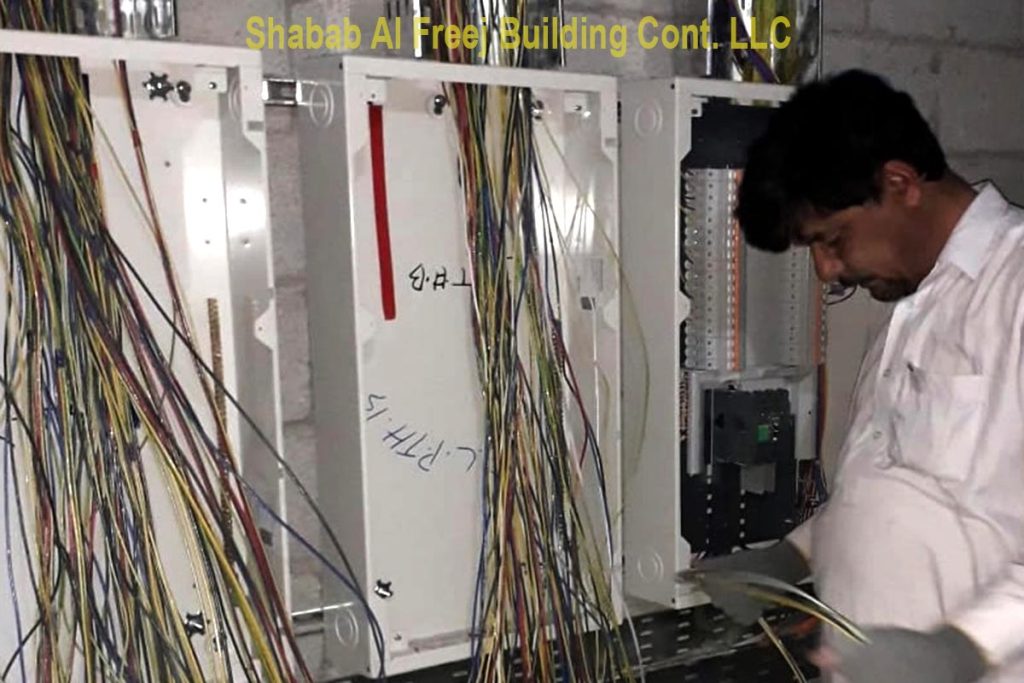Electrical Wiring Services in Dubai and Sharjah
What Is Electrical Wiring
Electrical wiring refers to the system of conductors, cables, and other electrical components that are used to transmit electrical power and signals from one location to another. It is a critical component of a building’s electrical system and is responsible for providing power to lights, appliances, and other electrical devices. Electrical wiring can be installed in different ways, including through walls, ceilings, and floors, and is typically made of copper or aluminum conductors covered with an insulating material to prevent electrical shocks and shorts.

Essential Components of Electrical Wiring Systems
Hot, neutral, and ground are three fundamental components of electrical wiring systems that play a crucial role in ensuring safe and efficient electrical supply to your home or business.
Hot: The hot wire is also known as the live wire or phase wire, and carries electrical current from the power source to the electrical device. This wire is typically colored black, red, or another dark color, and is always energized with voltage. It is important to note that the hot wire can cause electrical shock or fire if touched, so it should always be treated with caution and respect.
Neutral: The neutral wire is responsible for completing the electrical circuit and carrying the electrical current back to the power source after it has been used by the electrical device. This wire is typically colored white or gray, and is not energized with voltage. In some cases, the neutral wire may also be used as a ground wire, but it is important to understand that this is not its primary function.
Ground: The ground wire is responsible for providing a safe path for electrical current to flow in the event of a fault or short circuit. This wire is typically colored green or bare copper, and is connected to the earth to provide a direct path for electrical current to flow away from people or objects. Grounding is an essential safety measure that helps prevent electrical shock or fire, and should be included in all electrical wiring systems.
It is important to understand the roles and functions of hot, neutral, and ground wires in electrical wiring systems to ensure safe and efficient electrical supply. It is also important to follow electrical code requirements and hire a licensed electrician for any electrical work, as they have the knowledge and expertise to handle these components safely and effectively.
Why Are Hot, Neutral, And Ground Wires Important?
Hot, neutral, and ground wires are important for safety and for the proper operation of your electrical system. Hot and neutral wires provide the electricity that powers your appliances and devices. Ground wires provide a safe path for electricity to flow in the event of a short circuit or other electrical fault. This helps to protect you from electrical shock.
How Do Hot, Neutral, And Ground Wires Work Together?
Hot, neutral, and ground wires work together to create a complete circuit. The hot wire carries electricity from the power source to an electrical device. The neutral wire completes the circuit and returns electricity to the power source. The ground wire provides a safe path for electricity to flow in the event of a short circuit or other electrical fault.
What Happens If Hot, Neutral, Or Ground Wires Are Not Connected Properly?
If hot, neutral, or ground wires are not connected properly, it can create a shock hazard. It can also damage your appliances and devices. It is important to have your electrical system inspected and repaired by a qualified electrician if you suspect that there is a problem with the hot, neutral, or ground wires.
Different Types of Electrical Wiring
Electrical wiring systems are an essential component of any building, whether residential, commercial or industrial. Here are some of the most common types of electrical wiring systems:
Tee System or Joint Box System:
This wiring system is a simple and easy-to-install option that involves running wires from the main distribution board to a series of junction boxes. From these boxes, individual cables can be run to different rooms or areas of the building. Tee system often used in smaller buildings.
Pros:
- Easy to install and maintain
- Cost effective
- Allows for easy expansion and modification
Cons:
- Not suitable for larger buildings or more complex electrical systems
- Less reliable over longer distances
- Cables and junction boxes may be visible
Looping or Loop in Wiring:
In a loop in system, all of the wires are connected in a continuous loop, with each light or power outlet connected to the loop. This system is easy to install and maintain, and allows for easy expansion and modification of the electrical system.
Pros:
- Easy to install and maintain
- Can be more reliable than tee system wiring
Cons:
- More expensive than tee system wiring
- May require additional cable length, which can increase installation costs
- More difficult to troubleshoot in case of electrical problems
Cleat Wiring:
Cleat wiring is a type of surface wiring where cables are attached to walls or ceilings using cleats or clips. This system is often used in industrial settings where the wiring needs to be exposed and easily accessible for maintenance purposes.
Pros:
- Easy to install and maintain
- Suitable for Industrial settings where the wiring needs to be easily accessible
- More durable in high-vibration environments
Cons:
- Less reliable than other wiring systems over longer distances
- Cables may be visible
Batten Wiring:
Batten wiring involves running cables along wooden battens that are attached to the walls or ceilings. This system is commonly used in residential buildings and can be an affordable and easy-to-install option.
Pros:
- Affordable option for residential settings
- More protective than cleat wiring
- More aesthetically pleasing, as cables may be hidden behind the battens
Cons:
- Less reliable than other wiring systems over longer distances
- Can be more difficult to modify or expand
Enclosure wiring or Casing and Capping Wiring:
This wiring system involves running cables through PVC pipes or metal conduits, which are then covered with casing or capping. This system is commonly used in commercial buildings where a more professional finish is required.
Pros:
- Professional finish than other surface wiring options
- Can be more durable in high-traffic areas
- Good option for commercial buildings
Cons:
- Can be more expensive than other wiring systems
- More difficult to install and maintain, particularly in tight spaces
Lead Sheathed Wiring:
Lead sheathed wiring involves running cables through lead sheaths, which are then covered with an outer layer of insulation. This system is commonly used in high-risk environments, such as chemical plants, where there is a risk of damage to the wiring from chemical exposure.
Pros:
- Provides excellent protection against chemical exposure and other environmental hazards
- Good option for industrial settings where safety is a top priority
Cons:
- Very expensive
- More difficult to install and maintain
Conduit Wiring:
Conduit wiring is a method of electrical wiring where a metal or plastic conduit is used to enclose and protect electrical wires. There are two types of conduit wiring: surface conduit wiring and concealed conduit wiring.
Surface Conduit Wiring: In surface conduit wiring, the conduit is mounted on the surface of the wall or ceiling and the wires run through it. This type of wiring is often used in buildings where it is not possible to conceal the wiring, such as in older buildings where the walls are made of solid masonry. One of the main advantages of surface conduit wiring is that it is easy to install and modify, making it a good choice for buildings where future modifications are likely to be made. However, it is less aesthetically pleasing than concealed conduit wiring and may be more vulnerable to damage.
Concealed Conduit Wiring: In concealed conduit wiring, the conduit is hidden behind the walls or ceiling, and the wires run through it. This type of wiring is commonly used in modern buildings where the wiring is hidden to provide a cleaner, more aesthetically pleasing appearance. One of the main advantages of concealed conduit wiring is that it provides greater protection for the wires than surface conduit wiring, making it less susceptible to damage from external factors. However, it is more difficult to install and modify than surface conduit wiring, making it a less flexible option for buildings where future modifications are likely to be made.
Types Of Conduits
Metallic Conduit:
As the name suggests, metallic conduits are made of metal. They come in different types, including rigid metal conduit (RMC), intermediate metal conduit (IMC), and flexible metal conduit (FMC). RMC is the most durable and offers the highest level of protection, making it suitable for outdoor and heavy-duty applications. IMC is lighter and easier to install, making it a popular choice for indoor applications. FMC is the most flexible and easiest to install, but it offers the least amount of protection.
Some advantages of metallic conduit include high durability, resistance to fire and corrosion, and good grounding properties. However, they can be more expensive and difficult to install compared to non-metallic conduits. Metallic conduits also require additional measures to prevent electrical interference.
Metallic conduits are widely used in electrical installations to protect and enclose wiring. They come in different types, including Class A and Class B conduits. Here is a closer look at each type:
Class A Conduit: Class A conduit, also known as rigid metal conduit (RMC), is the most durable type of metallic conduit. It is made of galvanized steel and has a thick wall, making it highly resistant to damage and impact. Class A conduit is typically used in outdoor and heavy-duty applications, such as industrial and commercial installations. It offers the highest level of protection for electrical wiring and is suitable for use in hazardous locations.
Some advantages of Class A conduit include high durability, excellent mechanical protection, and resistance to fire, water, and corrosion. However, it is the most expensive and difficult to install compared to other types of metallic conduits.
Class B Conduit: Class B conduit, also known as intermediate metal conduit (IMC), is a lighter and more affordable alternative to Class A conduit. It is made of galvanized steel and has a thinner wall compared to Class A conduit. Class B conduit is typically used in indoor applications, such as residential and commercial buildings. It is also suitable for use in hazardous locations.
Some advantages of Class B conduit include ease of installation, affordability, and good mechanical protection. However, it is less durable and offers lower levels of protection compared to Class A conduit. It may not be suitable for outdoor or heavy-duty applications.
Non-Metallic Conduit:
Non-metallic conduits are made of materials such as PVC, HDPE, or fiberglass. They are typically lighter and easier to install than metallic conduits. PVC is the most common type of non-metallic conduit and is suitable for most indoor applications.
Advantages of non-metallic conduit include low cost, ease of installation, and resistance to corrosion and chemicals. Non-metallic conduits are also less prone to electrical interference and do not require grounding. However, they are less durable and may not be suitable for outdoor or heavy-duty applications.
